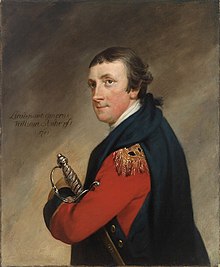
Summary
Lieutenant General William Amherst (5 February 1732 – 13 May 1781) was a British military commander. In 1762 during the Seven Years' War he led British forces that defeated a French expedition which had occurred earlier that year in St. John's, Newfoundland at the Battle of Signal Hill.
William Amherst | |
|---|---|
 Lieutenant General William Amherst | |
| Born | 5 March 1732 Sevenoaks, Kent, England |
| Died | 13 May 1781 (aged 49) England |
| Allegiance | Kingdom of Great Britain |
| Service/ | British Army |
| Rank | Lieutenant-general |
| Battles/wars | Seven Years' War |
| Relations | William Pitt Amherst, 1st Earl Amherst of Arracan (son) Elizabeth Frances Amherst (daughter) |
Early life edit
William Amherst was born, in Sevenoaks, Kent, into a family of lawyers.[1] He married Elizabeth Amherst (Patterson). Their children included:
Seven Years' War edit
Amherst was commissioned as an ensign in the First Regiment of Foot Guards in 1755.[2] He eventually rose to the rank of lieutenant general in 1779.[2] As a lieutenant colonel, Amherst was instrumental in the re-capture of St. John's from the French in 1762 at the Battle of Signal Hill.[2] An area near Signal Hill at the entrance of St. John's harbour is named "Fort Amherst" in commemoration of his victory in 1762.
In 1766 he became Member of Parliament for Hythe,[3] and in 1768 he became MP for Launceston until 1774.[4]
In 1769 he built a house in Ryde, on the Isle of Wight. He named the house and estate St John's, after his victory in Newfoundland. The neighborhood of Ryde that surrounds the house is still known by that name.[5]
He was appointed Adjutant-General to the Forces in 1778:[6] he died while serving in that role in 1781.[7]
Notes edit
- ^ Chartrand p.24.
- ^ a b c d The Recapture of St. John's, Newfoundland in 1762
- ^ "Leigh Rayment's House of Commons pages". Archived from the original on 19 December 2012. Retrieved 8 May 2009.
{{cite web}}: CS1 maint: unfit URL (link) - ^ "Leigh Rayment's House of Commons pages". Archived from the original on 19 December 2012. Retrieved 8 May 2009.
{{cite web}}: CS1 maint: unfit URL (link) - ^ Parks and gardens UK, St John's House, (also known as Bishop Lovett Middle School), St John's Ryde, England
- ^ "No. 11937". The London Gazette. 22 December 1778. p. 1.
- ^ Light Infantry[permanent dead link]
References edit
- Chartrand, René (2000), Louisbourg 1758: Wolfe's first siege, Oxford: Osprey
External links edit
- Biography at Newfoundland Grand Banks
- The Rooms article on Conflict in Newfoundland


